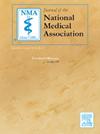Beyond hair loss: Exploring the psychiatric burden of alopecia areata in a large cohort
IF 2.3
4区 医学
Q1 MEDICINE, GENERAL & INTERNAL
引用次数: 0
Abstract
Background
Alopecia areata is a non-scarring autoimmune condition that causes hair loss and is increasingly linked to mental health disorders. This study examined the incidence of psychiatric conditions among patients newly diagnosed with alopecia areata and explored demographic differences in psychiatric outcomes.
Methods
A retrospective cohort study was conducted using the TriNetX Global Collaborative Network. A total of 97,925 patients with a new diagnosis of alopecia areata were identified using diagnostic codes. After exclusions, 91,302 patients were included in the final analysis. Over a one-year follow-up period, the incidence of depression, anxiety, schizophrenia, obsessive-compulsive disorder, and adjustment disorders was assessed. Survival analysis and risk calculations were performed, and demographic data were analyzed to identify disparities.
Results
Mental health conditions were common in patients with alopecia areata. Anxiety was the most frequent psychiatric diagnosis, affecting 3.1 % of patients, followed by depression at 1.6 %. Adjustment disorders, schizophrenia, and obsessive-compulsive disorder were less common but still present. Patients diagnosed with these conditions experienced repeated episodes, with the highest average episodes per patient seen in those with depression, followed by anxiety. Kaplan-Meier survival analysis showed high probabilities of remaining free from psychiatric conditions during the study period. The average age of patients was 49 years, and 72.06 percent were female. The racial distribution was predominantly White (58.24 %), followed by Black or African American (16.85 %), with other racial groups represented in smaller proportions.
Conclusion
Patients with alopecia areata face a substantial mental health burden, highlighting the need for integrated medical and psychological care.
超越脱发:在一个大队列中探索斑秃的精神负担。
背景:斑秃是一种非瘢痕性自身免疫性疾病,可导致脱发,并越来越多地与精神健康障碍联系在一起。本研究考察了新诊断的斑秃患者的精神疾病发生率,并探讨了精神疾病结局的人口统计学差异。方法:采用TriNetX全球协作网络进行回顾性队列研究。共有97,925例新诊断为斑秃的患者使用诊断代码进行了鉴定。排除后,91,302例患者被纳入最终分析。在一年的随访期间,评估抑郁、焦虑、精神分裂症、强迫症和适应障碍的发生率。进行生存分析和风险计算,并分析人口统计数据以确定差异。结果:斑秃患者普遍存在心理健康问题。焦虑是最常见的精神诊断,影响3.1% %的患者,其次是抑郁症,占1.6% %。适应障碍、精神分裂症和强迫症不太常见,但仍然存在。被诊断患有这些疾病的患者会反复发作,抑郁症患者的平均发作次数最高,其次是焦虑。Kaplan-Meier生存分析显示,在研究期间没有精神疾病的可能性很高。患者平均年龄49岁,女性占72.06%。种族分布以白人为主(58.24 %),其次是黑人或非裔美国人(16.85 %),其他种族所占比例较小。结论:斑秃患者面临着巨大的心理健康负担,强调了医疗和心理综合护理的必要性。
本文章由计算机程序翻译,如有差异,请以英文原文为准。
求助全文
约1分钟内获得全文
求助全文
来源期刊
CiteScore
4.80
自引率
3.00%
发文量
139
审稿时长
98 days
期刊介绍:
Journal of the National Medical Association, the official journal of the National Medical Association, is a peer-reviewed publication whose purpose is to address medical care disparities of persons of African descent.
The Journal of the National Medical Association is focused on specialized clinical research activities related to the health problems of African Americans and other minority groups. Special emphasis is placed on the application of medical science to improve the healthcare of underserved populations both in the United States and abroad. The Journal has the following objectives: (1) to expand the base of original peer-reviewed literature and the quality of that research on the topic of minority health; (2) to provide greater dissemination of this research; (3) to offer appropriate and timely recognition of the significant contributions of physicians who serve these populations; and (4) to promote engagement by member and non-member physicians in the overall goals and objectives of the National Medical Association.

 求助内容:
求助内容: 应助结果提醒方式:
应助结果提醒方式:


